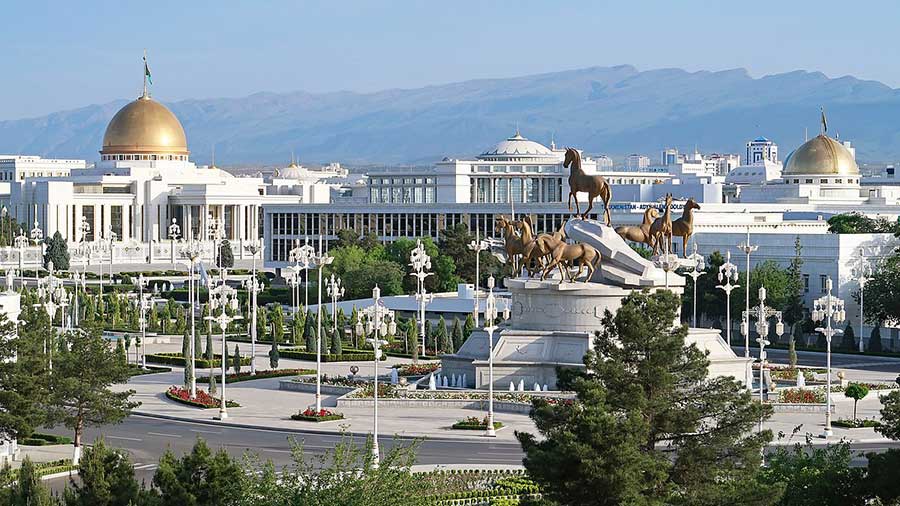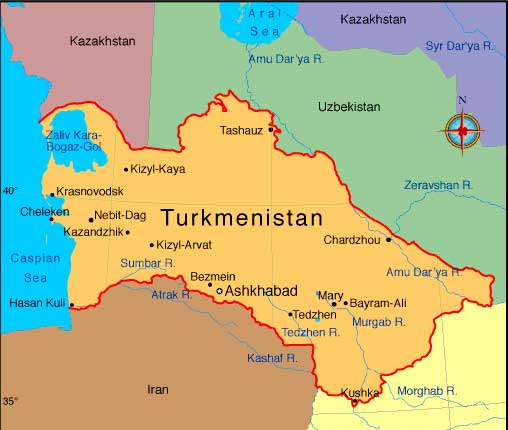Turkmenistan’s Opportunities and Challenges from China’s Belt & Road Initiative
The BRI is opening up Turkmenistan to China and other important markets in Central Asia and the Middle East

View of Asgabat, Turkmenistan’s Capital City
By Farzad Ramezani Bonesh
Turkmenistan lies off the east coast of the Caspian Sea. Since its independence from the Soviet Union, it has adhered to the policy of “positive neutrality”. China and Turkmenistan established diplomatic relations in January 1992.
The relationship between Turkmenistan and China has seen the signing of several bilateral agreements and treaties such as the Bilateral Investment Treaty (BIT) in 1992 and the Double Taxation Agreement (DTA) in 2009 amid numerous official visits.
In 2013, intergovernmental relations between Beijing and Ashgabat became strategic and an important document1 was signed. Their relationship was upgraded to a strategic partnership in 2014.
Introduction
Over the last decade, the two countries have expanded their diplomatic presence in each other’s countries. For example, Turkmenistan has strengthened its political and economic relations by opening a visa center in China and enlisting programmes to attract Chinese tourists.
In 2022, officials and leaders of China and Turkmenistan met at the “Central Asia and China” online summit, the opening of the Beijing Winter Olympic Games, and the Shanghai Cooperation Organization Summit in Samarkand.
The recent official visit of the President of Turkmenistan Serdar Berdimuhamedov to China in January 2023 (the first official visit to Beijing) was announced as the development of comprehensive strategic cooperation4 between Turkmenistan and China.
Several memorandums of understanding were signed in the digital economy, green development, revitalization of the Great Silk Road, and BRI5, energy, education, tourism, and so on.
China’s Goals and Interests
In line with its independent economic and foreign policy and economic goals, China is expanding and deepening its BRI cooperation with Turkmenistan.
In the first meeting of the heads of C+C5 countries, China asked Turkmenistan to increase industrial cooperation, investment, and win-win cooperation in BRI and to increase regional industrial development in sectors such as goods transit as well as the digital economy, energy, and agriculture.
In fact, China by using BRI, seeks to expand transportation and logistics infrastructure, trade links, prosperity, new opportunity for stability and growth, investment, technology and new markets, exports, industries, industrial promotion, green and digital economy, reducing electricity shortage, and increasing exchanges.
In addition, China’s foreign aid is also focused on Turkmenistan based on China’s national goals. They are a form of South-South cooperation and serve to strengthen the BRI.
In the China-Central Asia-West Asia BRI corridor, two BRI routes pass through Turkmenistan. These are the Route 3 or Kazakhstan-Uzbekistan-Turkmenistan-Iran corridor, thus forming part of the INSTC. This corridor runs Farab, Mary, and Sarkhes to Iran.
Route 4, or the Kyrgyzstan-Uzbekistan-Turkmenistan corridor passes via Meri, and Sarkhes.
Turkmenistan thus acts as China’s corridor for cooperation in the cross-border transportation system, increasing the number and volume of container train traffic and reaching the markets of South Asia, the Middle East, Eastern Europe, and the Caspian Sea. Beijing also wants to reach the West through Turkmenistan and the Central Asia-Caspian Sea-Caucasus route.
From China’s point of view, there are good opportunities for commercial and economic cooperation, expansion of trade volume, diversification, and agreement on a list of priority economic projects.
China seeks to expand opportunities with BRI in Turkmenistan. Therefore, it considers effective measures to expand the range of mutual investments, the implementation of documents, the expansion of investment in the digital economy, and green development.
Turkmenistan has the fourth largest proven natural gas reserves in the world. This is a resource that can help green the Belt and Road Initiative.
As China became the world’s largest energy consumer, the relationship between China and Turkmenistan, the Caspian region with significant oil and gas reserves, was incorporated into Beijing’s energy supply system.
The BRI in Turkmenistan can help to diversify energy supply sources for China and reduce coal consumption. Also, BRI will make energy security more accessible and reduce dependence on the Strait of Malacca.
Beijing and Ashgabat have been cooperation partners in the field of gas since 2016. Turkmenistan exports its natural gas to China through the Central Asia-China gas pipeline or three pipelines from the Turkmenistan-Uzbekistan-Kazakhstan route. Most of the natural gas is supplied by Turkmenistan.
Now, the BRI is assisting by speeding up the implementation of the second phase of the industrial development of the Galkynysh field, advancing the process of gas cooperation negotiations, and the construction of Line D of the Turkmenistan-China gas pipeline.
Line D will go to China from the different route of ‘Uzbekistan-Tajikistan-Kyrgyzstan’. Its construction and operation will increase Turkmenistan’s annual export to China to 65 billion13 cubic meters.
From China’s point of view, Ashgabat is a suitable partner far from the projects dominated by Moscow. In 2020, Chinese companies signed 27 new project contracts with a total value of US$457 million in Turkmenistan. Most of China’s new projects are mainly contracted and implemented in the fields of natural gas and development14 services.
A list of agreements on the role of expanding the BRI in the economy of Turkmenistan, infrastructure projects, and other economic sectors, and the completion of the construction of Luban workshops is also considered by Beijing.

Turkmenistan’s Belt & Road Initiative Goals and Interests
Turkmenistan see China as its most important partner and is a priority of its foreign economic policy. With Turkmenistan’s neutral policy, Ashgabat supports the principle of one China, and Beijing’s interests in Taiwan and Xinjiang.
Turkmenistan’s leaders have already discussed whether to play a more active role in BRI; and have been able to advance their goals by participating in the BRI project.
The two countries do not have a common border, but Turkmenistan’s plan for development and the country’s position on the BRI route have also made Ashgabat pay attention to partnering with China, becoming a regional transportation hub.
China’s BRI is synchronized with Turkmenistan’s National Plan for the Socio-Economic Development for 2022-2052, in addition to the Turkmen Socio-Economic Development Plan in 2022-2028, the National Economic Diversification Strategy, and Turkmenistan’s Foreign Trade Strategy 2021-2030, all further developing Turkmenistan’s foreign economic relations, especially with Beijing, and attracting investment capital to the country as a result.
These include the repositioning of Turkmenistan as a logistics and transport hub to assist Central Asia’s landlocked countries access to maritime routes, and has particular significance for Uzbekistan, Kyrgyzstan and Afghanistan. In addition, both Turkmenistan realises its potential for adding value as goods move along supply chains. These strategies also call for the development of free trade and other economic zones along these routes to provide value added processing to goods transiting these routes – in both directions. The Middle East has also become interested in Turkmenistan and is looking to fellow Islamic markets in Eurasia. Turkmenistan therefore becomes a key bridge between the Middle East and Central Asia.
Increasing gas production in the sea and onshore, attracting foreign investment, increasing oil production, as well as newly discovered areas in the Caspian region also require BRI assistance.
Ashgabat is eager to increase the gas export and transmission capacity to 65 billion cubic meters with the D pipeline and provide more income.
With BRI, Turkmenistan aims to transform the country from an agricultural to an industrial country, integrate and expand sustainable international transportation cooperation 16 , become one of the transportation and communication centers in the East-West and North, and join the World Trade Organization.
Turkmenistan 2022-2023 Trade & GDP Growth Prospects
Turkmenistan’s real gross domestic product (GDP) grew by 6.2% from January to September 2022 compared to the previous year. China is the most important trade partner of Turkmenistan. 70% of Turkmenistan’s exports, mainly gas, are transported to China.
Bilateral trade in 2023 is expected to exceed US$11 billion dollars, which has grown by 52% compared to the same period of the previous year. The balance in bilateral trade is completely in favour of Turkmenistan due to the exchange of natural gas.
Obstacles and Prospects
The threats facing the BRI in the Caspian region are the legal status of the Caspian Sea, the strict neutrality policy and the extreme political, self-maintained isolation of Ashgabat, the dominance of government institutions over the economy, logistical risks, and limitations in infrastructure.
In addition, China denies any ulterior motives in the BRI, but critics of “debt trap diplomacy” rule out imposing harsh conditions on borrowers, the terms of Chinese loans, confidential or unusual clauses, while obscurities in details, low-priced gas sales, and increased dependence on Beijing for gas exports and provision of foreign exchange resources have raised concerns. Also, the construction of the D gas line has been delayed for years. Therefore, it is important to solve the logistical, technological, and political challenges of its launch.
However, the bilateral opportunities for both countries are higher than the threats. The increase in the volume of China-Kyrgyzstan-Turkmenistan-Iran railway transport, the construction of the China-Kyrgyzstan-Uzbekistan, the China-Kazakhstan-Turkmenistan-Iran railway corridor, and the expansion of Turkmenistan’s transit trade volume with Azerbaijan and INSTC routes to Iran and beyond will open up more non-China opportunities for Turkmenistan.
It seems that gas cooperation will be the cornerstone of the China-Turkmenistan BRI, and investment in strategic fields such as the chemical industry, transportation, and communication 19will be expanded and deepened. In this regard, the plan of extensive cooperation and deepening of work on BRI 20in the upcoming summit of Central Asian countries-China can lead to strengthening the role and position of BRI in Turkmenistan – as well as allow the country to develop its own trade relations beyond China.
Related Reading





